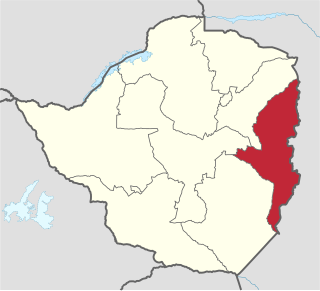
Manicaland is a province in eastern Zimbabwe. After Harare Province, it is the country's second-most populous province, with a population of 2.037 million, as of the 2022 census. After Harare and Bulawayo provinces, Manicaland is Zimbabwe's third-most densely populated province. Manicaland was one of five original provinces established in Southern Rhodesia in the early colonial period. The province endowed with country's major tourist attractions, the likes of Mutarazi Falls, Nyanga National Park and Zimbabwe's top three highest peaks. The province is divided into ten administrative subdivisions of seven rural districts and three towns/councils, including the provincial capital, Mutare. The name Manicaland is derived from one of the province's largest ethnic groups, the Manyika, who originate from the area north of the Manicaland province and as well as western Mozambique, who speak a distinct language called ChiManyika in Shona.

Mutare, formerly known as Umtali until 1982, is the most populous city in the province of Manicaland, and the third most populous in Zimbabwe, having surpassed Gweru in the 2012 census, with an urban population of 224,802 and approximately 260,567 in the surrounding districts, giving the wider metropolitan area a total population of over 500,000 people. Mutare is also the capital of Manicaland Province and the largest city in eastern Zimbabwe.

Nyanga, originally known as Inyanga, is a town in Zimbabwe.

The Honde Valley extends from the eastern border of Zimbabwe into Mozambique. The valley is part of the Eastern Highlands. The valley is about 130 kilometres from Mutare, or 110 kilometres from Nyanga. The Nyanga Mountains and the Nyanga National Park form the western boundary of the valley.
The Manyika tribe is a Shona sub-group that originated from Manyika Dynasty. Manyika people speak several dialects which include ChiManyika, ChiBocha, ChiUngwe, ChiHera, Chijindwi and the Urban dialect which is spoken in urban centers like Mutare and Rusape.
Marondera, originally known as Marandellas, is a city in Mashonaland East, Zimbabwe, located about 72 kilometres (45 mi) east of Harare.
Nyazura is the second largest urban settlement in Makoni District in Manicaland Province, Zimbabwe located 72 km north-west of Mutare on the main road and railway linking Harare and Mutare. The settlement is named after the Nyazure River which is a tributary of the Save River. The phosphate from Dorowa are handled by the railways here. The town is located 191km from Harare along the Harare Mutare Highway. It is 20 kilometres from Rusape and 70km from Mutare. The major part of Nyazura is believed to be under the rule of the Rukweza family.
Tsanzaguru is a township, commuter zone, in the province of Manicaland, Zimbabwe located 10 km south of Rusape in the Makoni West constituency. It is situated by the riverside overlying the Rusape Dam. Named after the kopje, Tsanzaguru, in the overlying village area of Headman Dzvairo, who is under Chief Makoni. The township is under Rusape Town Council and almost three quarters of the small employed population are employed by government either in the army, education or other government enterprises.
Watsomba is a shopping centre in the province of Manicaland, Zimbabwe located 42 km north of the city of Mutare on the main Mutare-Nyanga road. It is an administrative and trading centre for Mutasa District and the Mutasa and Manyika communal lands. Around Watsomba are farms surrounding the growth point namely ruwodo farm, muringami farm, sakupwanya farm, madziwa farm, sagonda farm, Nyamutaira farm, Mutasa farm, Mandimutsira farms, Mundoma farm, Mvere Farm, Nyakurukwa Farm and Makoni Farm.
Chisumbanje is an area located in the province of Manicaland in Zimbabwe. It is situated in Chipinge District, one of seven districts in the province. It is located in Dowoyo communal land on the eastern bank of the Save River, about 95 km (59 mi) south of Birchenough Bridge on the Birchenough Bridge-Chiredzi road.

Makoni District is a district in Manicaland Province of northeastern Zimbabwe.
St Faith's High School, Rusape, Manicaland is a mission school 17 km from Rusape, Zimbabwe.
Mutasa District is one of seven districts in Manicaland Province of Zimbabwe. Mutasa District is located 30 km northeast of Mutare and stretches up to the Honde Valley, which is about 100 km northeast of Mutare along a tarred road that branches off the Nyanga road.
Evans Chikwaikwai is a Zimbabwean footballer who has played as a striker for Bidvest Wits in the South African Premier Soccer League.

Nyanga District is located in Manicaland Province of Zimbabwe.
Sakubva township is a high-density suburb in the city of Mutare, Zimbabwe, which contains nearly a quarter of the population of Mutare despite an area of less than four square miles. It was the first high-density suburb (township) being established in Mutare. At that time, it was located in the Old Location section of Sakubva. It is the poorest of Mutare's suburb and its economy is centred on a large outdoor food and flea market.

Mutare District is a district in Manicaland Province of eastern Zimbabwe. The district headquarters is the city of Mutare.
Christopher Peter Mutekwatekwa Chingosho is a Zimbabwean politician who is currently a member of the National Assembly of Zimbabwe for Headlands since 2015. He also served as deputy minister of local government and housing from 2017 to 2018. Previously, he worked in several government ministries and as a district and provincial administrator. He is a member of ZANU–PF, having joined the party in Mozambique during the Rhodesian Bush War in 1975.







